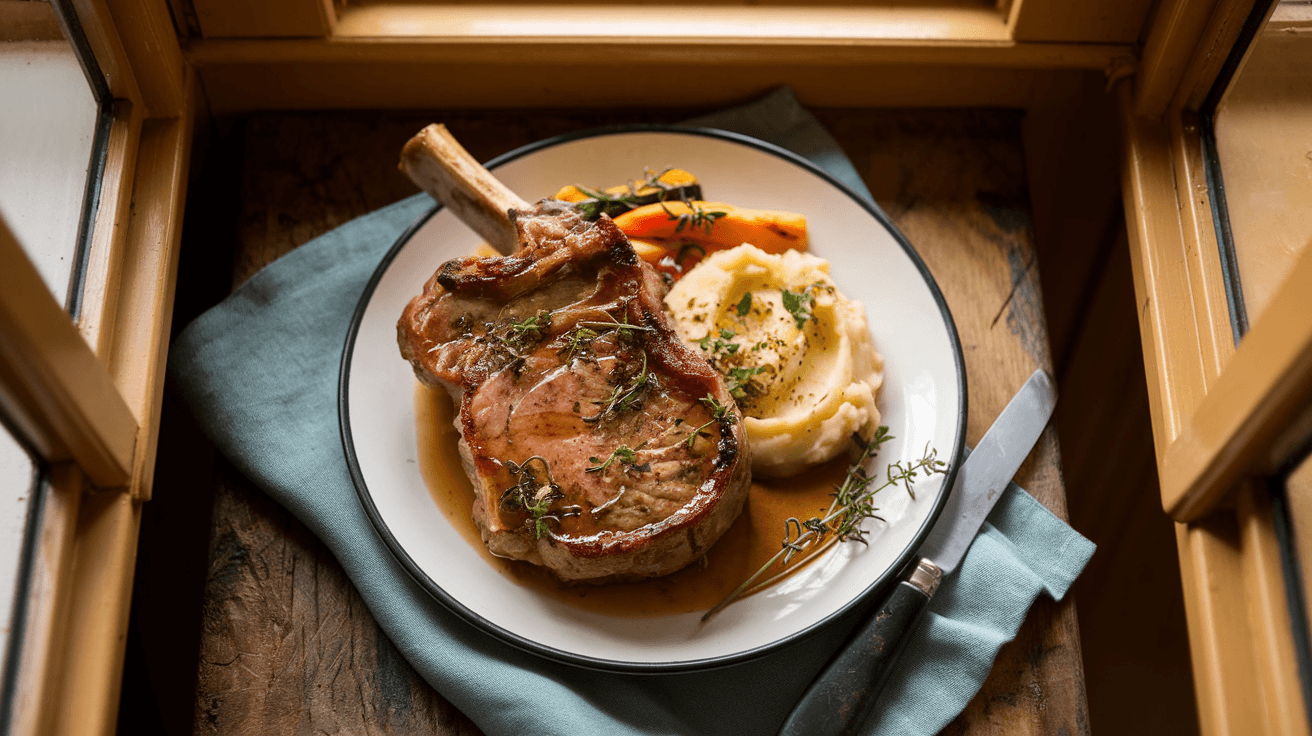Can You Cook Pork Chops Low and Slow?
Cooking pork chops low and slow is a time-honored method that yields tender, juicy, and flavorful results. This approach allows the meat to cook gently, breaking down connective tissues and infusing it with rich flavors from your chosen seasonings or liquid base. But is this method truly effective for pork chops, and how can you master it at home?
In this article, we’ll explore the benefits of low-and-slow cooking, the best cuts to use, and techniques to ensure perfect results every time. Whether you’re using a slow cooker, oven, or stovetop, this guide will help you unlock the full potential of this delicious method.
The Benefits of Cooking Pork Chops Low and Slow
Cooking pork chops low and slow offers several advantages that make it a preferred method for achieving tender and flavorful results. This technique is particularly effective for tougher cuts of pork, transforming them into juicy, melt-in-your-mouth dishes.
Improved Tenderness
- Why It Works: Low and slow cooking gently breaks down the muscle fibers and connective tissues in pork, resulting in a tender texture that’s hard to achieve with faster cooking methods.
- Best for Tougher Cuts: Bone-in or shoulder chops benefit most from this method, as their higher fat content and collagen render down slowly, adding moisture and flavor.
Enhanced Flavor
- Deep Flavor Infusion: Cooking slowly allows seasonings, herbs, and other ingredients to fully penetrate the meat, creating layers of flavor.
- Perfect for Sauces and Gravies: The slow cooking process produces rich juices that can be used to create delicious gravies or sauces to complement your pork chops.
The low-and-slow method isn’t just about tenderness; it’s a way to elevate the overall flavor profile of your dish, making it ideal for hearty, comforting meals.
Best Cuts for Low and Slow Cooking
Not all pork chops are created equal when it comes to low-and-slow cooking. Choosing the right cut is crucial to achieving tender and flavorful results.
Bone-In Pork Chops
- Why They’re Ideal: Bone-in pork chops retain moisture better during long cooking times. The bone adds flavor to the meat and helps maintain its structure.
- Best Cooking Methods: Bone-in chops work wonderfully in slow cookers or oven-braised recipes, where the gentle heat breaks down the meat’s fibers.
Shoulder Chops
- Why They’re Ideal: Shoulder chops, also known as blade chops, have a higher fat content and more connective tissue, making them perfect for low-and-slow methods.
- Best Cooking Methods: These cuts excel in recipes involving braising or slow cooking, where the fat and collagen have time to render down, resulting in a tender and flavorful dish.
Thick-Cut Pork Chops
- Why They’re Ideal: Thicker cuts are less likely to dry out during extended cooking. They can hold up to the low-and-slow method without losing their moisture.
- Best Cooking Methods: Great for slow cooking or oven-baking, as they allow even heat distribution throughout the meat.
Selecting the right cut ensures your pork chops remain juicy and tender, making every bite a flavorful experience.
How to Cook Pork Chops Low and Slow
Mastering the low-and-slow cooking method involves proper preparation, choosing the right technique, and ensuring consistent temperatures. Here’s a step-by-step guide to achieve perfect results.
Preparing the Pork Chops
- Trim Excess Fat: While some fat enhances flavor, too much can create a greasy dish. Trim any excess fat, leaving a thin layer for moisture.
- Season Generously: Rub the pork chops with a mixture of salt, pepper, garlic powder, paprika, or your preferred spices. Allow them to rest for 20–30 minutes to absorb the flavors.
- Marinate (Optional): For added flavor, marinate the pork chops in a mixture of olive oil, vinegar, and herbs for a few hours or overnight.
Low and Slow Cooking Techniques
Using a Slow Cooker
- Step 1: Layer the bottom of the slow cooker with aromatics like onions, garlic, or fresh herbs.
- Step 2: Place the seasoned pork chops on top, ensuring they’re not overcrowded.
- Step 3: Add a liquid base, such as chicken broth, apple juice, or a creamy sauce, to cover the bottom third of the chops.
- Step 4: Cook on low for 6–8 hours or high for 3–4 hours. Check for tenderness before serving.
Oven-Baking
- Step 1: Preheat the oven to 300°F (150°C) and place a baking rack inside a roasting pan.
- Step 2: Arrange the pork chops on the rack and cover them with foil to trap moisture.
- Step 3: Bake for 1.5–2 hours, checking periodically to ensure the meat stays moist.
- Step 4: Remove the foil for the last 15 minutes to allow the chops to brown.
Stovetop Braising
- Step 1: Heat a heavy skillet over medium heat and sear the pork chops for 2–3 minutes per side until browned.
- Step 2: Add a flavorful liquid, such as wine, broth, or tomato sauce, to cover the bottom of the skillet.
- Step 3: Reduce the heat to low, cover, and simmer for 45–60 minutes until the chops are tender.
By following these techniques, you’ll achieve pork chops that are tender, juicy, and infused with rich flavors.
check out our Slow Cooker Pork Chops
Common Mistakes to Avoid When Cooking Low and Slow
Even with the best intentions, a few common mistakes can ruin your low-and-slow pork chop recipe. Avoid these pitfalls to ensure your chops turn out perfectly every time.
Overcrowding the Pan or Slow Cooker
- Why It’s a Problem: When pork chops are packed too tightly, they cook unevenly, and the juices can’t circulate properly. This leads to uneven cooking and potential dryness.
- Solution: Leave enough space between each chop to allow for even heat distribution. If necessary, cook in batches.
Forgetting to Add Liquid
- Why It’s a Problem: Liquids are essential for keeping pork chops moist during long cooking times. Without enough liquid, the meat can dry out.
- Solution: Always add a liquid base, such as broth, wine, or a creamy sauce, to create steam and retain moisture.
Using Thin-Cut Pork Chops
- Why It’s a Problem: Thin pork chops cook too quickly and are prone to drying out in slow-cooking methods.
- Solution: Opt for thick-cut or bone-in pork chops, which hold up better during extended cooking.
Overcooking
- Why It’s a Problem: Even with low-and-slow cooking, leaving the pork chops in for too long can make them tough and dry.
- Solution: Use a meat thermometer to monitor the internal temperature. Pork is done at 145°F (63°C), and resting the chops will allow the temperature to rise slightly.
Not Searing First
- Why It’s a Problem: Skipping the searing step means missing out on the caramelized flavors that come from browning the meat.
- Solution: Before slow cooking, quickly sear the pork chops on a hot skillet for 2–3 minutes per side.
Avoiding these mistakes ensures that your pork chops remain tender, juicy, and full of flavor.
Creative Recipes for Low and Slow Pork Chops
Low-and-slow cooking offers endless possibilities for crafting flavorful pork chop dishes. Here are some creative recipes to try, each highlighting the versatility of this method.
Slow Cooker Honey Garlic Pork Chops
- Flavor Profile: Sweet, savory, and aromatic.
- Ingredients:
- Bone-in pork chops
- 1/4 cup honey
- 4 garlic cloves (minced)
- 1/4 cup soy sauce
- 1 tablespoon apple cider vinegar
- Instructions:
- Combine honey, garlic, soy sauce, and vinegar to create the sauce.
- Layer the pork chops in the slow cooker and pour the sauce over them.
- Cook on low for 6 hours. Serve with steamed rice or roasted vegetables.
Braised Pork Chops with Apples and Onions
- Flavor Profile: Sweet and savory with a hint of tartness.
- Ingredients:
- Thick-cut pork chops
- 2 apples (sliced)
- 1 large onion (sliced)
- 1 cup chicken broth
- 1/4 cup apple cider
- Instructions:
- Sear the pork chops and set aside.
- Sauté apples and onions until softened, then deglaze with apple cider.
- Add the pork chops back into the skillet, pour in the chicken broth, cover, and simmer for 1 hour.
Creamy Mushroom Pork Chops
- Flavor Profile: Rich, creamy, and comforting.
- Ingredients:
- Pork chops
- 1 cup heavy cream
- 1 cup sliced mushrooms
- 1/2 cup chicken broth
- 1 teaspoon thyme
- Instructions:
- Sear the pork chops and remove them from the skillet.
- Sauté mushrooms and thyme, then deglaze with chicken broth.
- Stir in heavy cream, add the pork chops back, and simmer for 45 minutes.
Barbecue-Style Pork Chops
- Flavor Profile: Smoky, tangy, and sweet.
- Ingredients:
- Pork chops
- 1/2 cup barbecue sauce
- 2 tablespoons brown sugar
- 1 teaspoon smoked paprika
- Instructions:
- Mix barbecue sauce, brown sugar, and paprika.
- Coat the pork chops with the mixture and place them in a slow cooker.
- Cook on low for 6–8 hours. Serve with cornbread or coleslaw.
These creative recipes showcase the versatility of slow-cooked pork chops, allowing you to enjoy a variety of flavors and textures.
Frequently Asked Questions (FAQs)
Can You Freeze Cooked Pork Chops from a Slow Cooker?
- Answer: Yes, slow-cooked pork chops can be frozen for later use.
- Pro Tip: Store them in an airtight container or freezer bag along with their cooking liquid to maintain moisture. They can last up to 3 months in the freezer.
What Liquid Should I Use for Slow-Cooked Pork Chops?
- Answer: Common liquids include chicken broth, apple juice, white wine, or a creamy sauce. The liquid adds moisture and enhances the flavor of the pork chops.
- Pro Tip: For a tangy twist, try adding a splash of apple cider vinegar or lemon juice.
How Long Should I Cook Pork Chops in a Slow Cooker?
- Answer: Cook pork chops on low for 6–8 hours or on high for 3–4 hours. The exact time depends on the thickness and type of pork chops you’re using.
- Pro Tip: Always check for tenderness before serving to avoid overcooking.
Can I Cook Frozen Pork Chops in a Slow Cooker?
- Answer: It’s not recommended to cook frozen pork chops directly in a slow cooker, as this can lead to uneven cooking.
- Pro Tip: Thaw pork chops in the refrigerator overnight for best results before slow cooking.
What’s the Best Side Dish for Slow-Cooked Pork Chops?
- Answer: Popular sides include mashed potatoes, roasted vegetables, or rice pilaf. These dishes soak up the rich flavors of the pork chop sauce.
- Pro Tip: Pair your meal with a fresh green salad for a balanced dinner.
For more slow-cooked pork inspiration, explore our Slow Cooker Pork Chops or browse our Dinner Recipes collection.
Conclusion
Cooking pork chops low and slow is a foolproof way to achieve tender, juicy, and flavorful results. Whether you’re using a slow cooker, oven-baking, or stovetop braising, this method allows the meat to absorb seasonings and develop deep, rich flavors. By choosing the right cuts, adding a flavorful liquid base, and avoiding common mistakes, you can master this technique and enjoy perfectly cooked pork chops every time.
From classic recipes like Honey Garlic Pork Chops to creative dishes like Braised Pork Chops with Apples and Onions, low-and-slow cooking opens up endless possibilities for flavorful meals. Don’t forget to pair your pork chops with complementary sides, such as mashed potatoes or roasted vegetables, to create a complete and satisfying dish.
For more ideas and inspiration, check out our Slow Cooker Pork Chops and browse through our Dinner Recipes for even more delicious meal options.
Embrace the art of slow cooking, and turn your next pork chop dish into a memorable culinary experience.

